
Bivalvia, in previous centuries referred to as the Lamellibranchiata and Pelecypoda, is a class of marine and freshwater molluscs that have laterally compressed bodies enclosed by a shell consisting of two hinged parts. As a group, bivalves have no head and they lack some usual molluscan organs, like the radula and the odontophore. They include the clams, oysters, cockles, mussels, scallops, and numerous other families that live in saltwater, as well as a number of families that live in freshwater. The majority are filter feeders. The gills have evolved into ctenidia, specialised organs for feeding and breathing. Most bivalves bury themselves in sediment, where they are relatively safe from predation. Others lie on the sea floor or attach themselves to rocks or other hard surfaces. Some bivalves, such as the scallops and file shells, can swim. The shipworms bore into wood, clay, or stone and live inside these substances.

The blue mussel, also known as the common mussel, is a medium-sized edible marine bivalve mollusc in the family Mytilidae, the mussels. Blue mussels are subject to commercial use and intensive aquaculture. A species with a large range, empty shells are commonly found on beaches around the world.
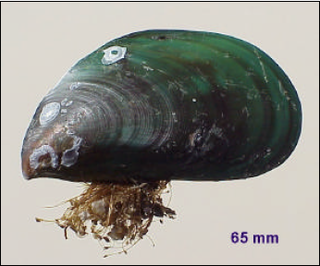
Perna viridis, known as the Asian green mussel, is an economically important mussel, a bivalve belonging to the family Mytilidae. It is harvested for food but is also known to harbor toxins and cause damage to submerged structures such as drainage pipes. It is native in the Asia-Pacific region but has been introduced in the Caribbean, and in the waters around Japan, North America, and South America.
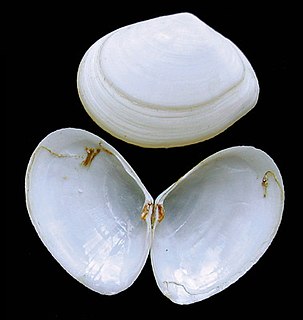
A bivalve shell is part of the body, the exoskeleton or shell, of a bivalve mollusk. In life, the shell of this class of mollusks is composed of two hinged parts or valves. Bivalves are very common in essentially all aquatic locales, including saltwater, brackish water, and freshwater. The shells of bivalves commonly wash up on beaches and along the edges of lakes, rivers, and streams. Bivalves by definition possess two shells or valves, a "right valve" and a "left valve", that are joined by a ligament. The two valves usually articulate with one another using structures known as "teeth" which are situated along the hinge line. In many bivalve shells, the two valves are symmetrical along the hinge line—when truly symmetrical, such an animal is said to be equivalved; if the valves vary from each other in size or shape, inequivalved. If symmetrical front-to-back, the valves are said to be equilateral, and are otherwise considered inequilateral.

Lajonkairia lajonkairii is an edible species of saltwater clam in the family Veneridae, the Venus clams.

Chlamys varia, also called Mimachlamys varia common name the variegated scallop, is a species of small scallop, a marine bivalve mollusk in the family Pectinidae, the scallops. It occurs in the North Sea, the English Channel, the northeastern Atlantic Ocean and the Red Sea.
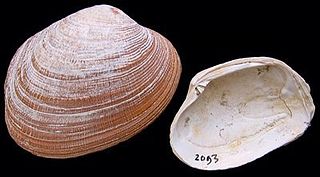
The grooved carpet shell, or Palourde clam, Ruditapes decussatus, or Venerupis decussatus, is a clam in the family Veneridae. It is distributed worldwide and due to its ecological and economic interest has been proposed as a bioindicator.
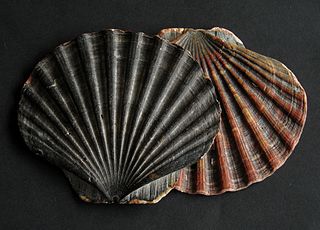
Pecten maximus, common names the great scallop, king scallop, St James shell or escallop, is a northeast Atlantic species of scallop, an edible saltwater clam, a marine bivalve mollusc in the family Pectinidae. This is the type species of the genus. This species may be conspecific with Pecten jacobaeus, the pilgrim's scallop, which has a much more restricted distribution.
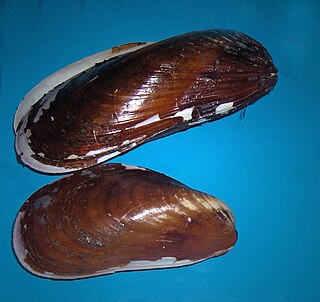
Modiolus modiolus, common name northern horsemussel, is a species of marine bivalve mollusk in the family Mytilidae.
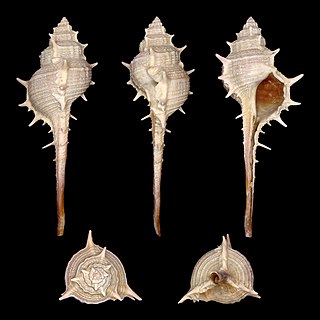
Murex trapa, common name the rare-spined murex, is a species of sea snail, a marine gastropod mollusc of the family Muricidae, the rock snails.

Talostolida teres, common name the tapering cowry, is a species of sea snail, a cowry, a marine gastropod mollusk in the family Cypraeidae, the cowries.

Lyncina vitellus, common name : the calf cowry or the Pacific deer cowry, is a species of sea snail, a cowry, a marine gastropod mollusk in the family Cypraeidae, the cowries.

Fabulina fabula, the bean-like tellin, is a species of marine bivalve mollusc in the family Tellinidae. It is found off the coasts of northwest Europe, where it lives buried in sandy sediments.
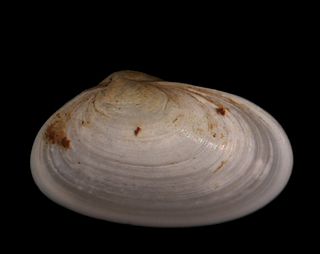
Tellimya ferruginosa is a species of small marine bivalve mollusc in the family Lasaeidae. It is found on the eastern side of the Atlantic Ocean.
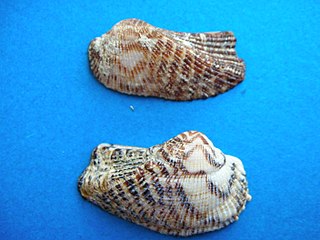
Arca noae or the Noah's Ark shell is a species of bivalve mollusc in the family Arcidae. It is found in the Mediterranean Sea from low tide mark to a depth of 60 metres (200 ft).

Modiolus albicostus is a species of "horse mussel", a marine bivalve mollusc in the family Mytilidae, the mussels.

Modiolus barbatus, the bearded horse mussel, is a species of "horse mussel", a marine bivalve mollusc in the family Mytilidae, the mussels.

Modiolus capax, common name fat horsemussel, is a species of "horse mussel", a marine bivalve mollusc in the family Mytilidae, the mussels. It was first described to science by American malacologist Timothy Abbott Conrad in 1837. The type specimen was collected in San Diego by Thomas Nuttall.
Arcuatula perfragilis is a bivalve mollusc of the mussel family, Mytilidae, which has an Indo-Pacific distribution including the Red Sea. It has invaded the eastern Mediterranean from the Red Sea by way of the Suez Canal, a process known as Lessepsian migration.
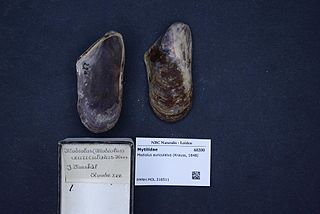
Modiolus auriculatus, the eared horse mussel, is a bivalve mollusc of the family, Mytilidae, which has a natural range in the Indian and Pacific Oceans. It has colonised the eastern Mediterranean Sea from the Red Sea by Lessepsian migration via the Suez Canal.





















